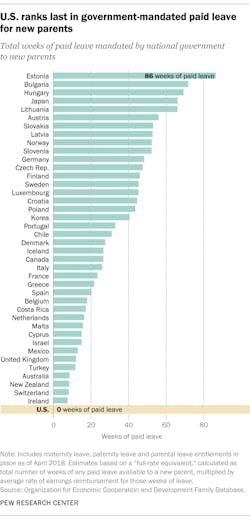While celebrating the 30th anniversary of the Family and Medical Leave Act (FMLA) on Feb. 5, which was signed into law by President Bill Clinton in 1993, The Society for Human Resource Management (SHRM) said it would like to see the U.S. have a national paid leave policy.
The FMLA requires qualified employers to grant up to 12 weeks of unpaid leave each year to eligible employees recovering from a medical condition, caring for sick family members or bonding with a newborn or adopted child.
But many businesses—around 40%—are not covered by this landmark legislation, the group notes.
This type of policy seems to be even more important in today’s workforce climate. “Employers are looking to (paid) leave to fight burnout and promote employee well-being, but the cost is prohibitive for many organizations, and we have seen leave for new parents return to pre-pandemic levels,” said SHRM Head of Public Affairs Emily M. Dickens, in a statement.
Dickens says that her organization is engaging with lawmakers to “create a system where workers and employers can tap into pooled resources to expand access and reduce risk and this requires a framework that can accommodate differences in work environments, industries and organizational size.
"As the FMLA turns 30, it is time to modernize our approach to family and medical leave. By advancing our recommendations, the federal government can remove barriers to success for workers caring for loved ones and employers that are unable to self-fund this vital benefit in order to retain top talent.”
The following are SHRM’s Paid Leave Principles:
- The creation of an insurance market for paid family and medical leave could potentially increase the availability of such programs for independent workers and small employers that lack the ability to self-fund.
- The use of a voluntary insurance-based approach would expand access to paid family and medical leave by allowing the financial burden to be shared among a group of employers instead of being borne by a single employer.
- The implementation of regulatory consistency would reduce administrative costs, increase participation by large employers and insulate the market from risk.
- The adoption of an “actuarially equivalent standard” with appropriate safeguards would allow for flexibility in benefit design at the organizational level.
The topic of national paid parental leave has been debated over the years. An article, “The urgent necessity for paid parental leave,” on the American Psychological Association website posted on April 2022, makes the case for the benefits of this leave.
“Paid parental leave can reduce financial stress, allow parents to focus on bonding with their child, and increase gender equality when fathers have more time to participate in childcare duties,” said psychologist Ashley Schappell D’Inverno, Ph.D., a behavioral scientist in the Division of Violence Prevention at the Centers for Disease Control and Prevention, in the article. “All of these positive effects trickle down to benefit the child and the family as a whole.”
From a mental health perspective, the article notes that “women who aren’t able to take as much time off—especially those who return to work in under 2 months—face more depressive symptoms and more marital and self-esteem problems. Even 2 to 3 years later, women who took shorter maternity leaves report more psychological distress."
US Policy Lagging
Looking at 41 nations, the U.S. is the only country that does not mandate any paid leave for new parents, according to data compiled by the Organization for Economic Cooperation and Development. The smallest amount of paid leave required in any of the other 40 nations is about two months.

